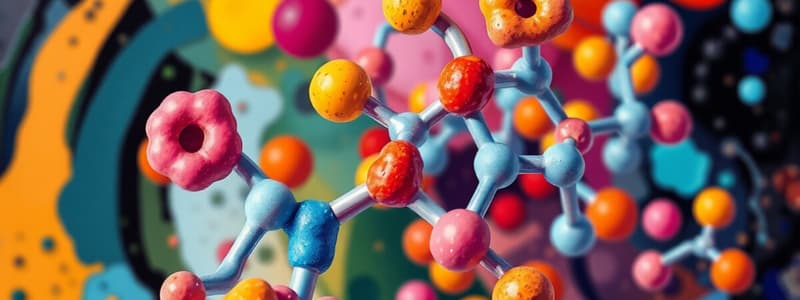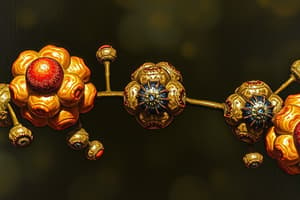Podcast
Questions and Answers
What are the two main functions of carbohydrates?
What are the two main functions of carbohydrates?
- Genetic material and enzyme functionality
- Energy supply and structural support (correct)
- Energy storage and communication
- Hormonal regulation and energy creation
What process is responsible for forming polymers from monomers?
What process is responsible for forming polymers from monomers?
- Photosynthesis
- Polymerization (correct)
- Cellular respiration
- Hydrolysis
Which complex carbohydrate do animals use to store extra sugar?
Which complex carbohydrate do animals use to store extra sugar?
- Cellulose
- Maltose
- Glycogen (correct)
- Lactose
What complex carbohydrate is primarily involved in giving strength and rigidity to plants?
What complex carbohydrate is primarily involved in giving strength and rigidity to plants?
Which type of carbohydrate is formed when sugars join together in long chains?
Which type of carbohydrate is formed when sugars join together in long chains?
What role does glycogen play in the body when blood glucose levels are low?
What role does glycogen play in the body when blood glucose levels are low?
Which macromolecules generally do not dissolve in water and are primarily composed of carbon and hydrogen atoms?
Which macromolecules generally do not dissolve in water and are primarily composed of carbon and hydrogen atoms?
What is the primary source of energy for human muscles derived from carbohydrates?
What is the primary source of energy for human muscles derived from carbohydrates?
What type of nutrient is primarily used as an energy source in living organisms?
What type of nutrient is primarily used as an energy source in living organisms?
Which of the following compounds is classified as a disaccharide?
Which of the following compounds is classified as a disaccharide?
How do scientists categorize macromolecules found in living organisms?
How do scientists categorize macromolecules found in living organisms?
Which macromolecule functions primarily in energy storage in plants?
Which macromolecule functions primarily in energy storage in plants?
What is the term used for single sugar molecules?
What is the term used for single sugar molecules?
What is the relationship between the number of hydrogen atoms and carbon or oxygen atoms in carbohydrates?
What is the relationship between the number of hydrogen atoms and carbon or oxygen atoms in carbohydrates?
Which macromolecule group is primarily composed of carbon and hydrogen and includes fats and oils?
Which macromolecule group is primarily composed of carbon and hydrogen and includes fats and oils?
Which of the following is not considered a type of carbohydrate?
Which of the following is not considered a type of carbohydrate?
What two functional groups are present in amino acids?
What two functional groups are present in amino acids?
What role do some proteins play in cellular processes?
What role do some proteins play in cellular processes?
What does the R-group in an amino acid structure represent?
What does the R-group in an amino acid structure represent?
How are amino acids linked together to form proteins?
How are amino acids linked together to form proteins?
Which property can differ among the side chains (R-groups) of amino acids?
Which property can differ among the side chains (R-groups) of amino acids?
What is the significance of the twenty different amino acids found in nature?
What is the significance of the twenty different amino acids found in nature?
Which of the following statements is true about proteins?
Which of the following statements is true about proteins?
Which element is NOT typically found in proteins?
Which element is NOT typically found in proteins?
What determines a protein's primary structure?
What determines a protein's primary structure?
Which of the following describes the secondary structure of proteins?
Which of the following describes the secondary structure of proteins?
What role do hydrogen bonds play in proteins?
What role do hydrogen bonds play in proteins?
What is the fourth level of protein structure concerned with?
What is the fourth level of protein structure concerned with?
What is one function of proteins in living organisms?
What is one function of proteins in living organisms?
What component of hemoglobin binds oxygen?
What component of hemoglobin binds oxygen?
What distinguishes saturated fatty acids from unsaturated fatty acids?
What distinguishes saturated fatty acids from unsaturated fatty acids?
Which macromolecule groups do fats, oils, and waxes belong to?
Which macromolecule groups do fats, oils, and waxes belong to?
What are the components of a nucleotide?
What are the components of a nucleotide?
Which level of protein structure is represented by the three-dimensional arrangement of a protein chain?
Which level of protein structure is represented by the three-dimensional arrangement of a protein chain?
Which statement about nucleic acids is correct?
Which statement about nucleic acids is correct?
What role do lipids play in biological systems?
What role do lipids play in biological systems?
Which of the following lipids is likely to be liquid at room temperature?
Which of the following lipids is likely to be liquid at room temperature?
What is the primary function of ATP in biological systems?
What is the primary function of ATP in biological systems?
Which sugar is found in ribonucleic acid (RNA)?
Which sugar is found in ribonucleic acid (RNA)?
Which type of acid contains nitrogen, carbon, hydrogen, and phosphorus?
Which type of acid contains nitrogen, carbon, hydrogen, and phosphorus?
Flashcards
Macromolecule
Macromolecule
A very large molecule made up of thousands of smaller units called monomers.
Monomer
Monomer
A small molecule that can be combined with other monomers to form a larger polymer.
Polymer
Polymer
A large molecule formed by joining many smaller monomers together.
Carbohydrate
Carbohydrate
Signup and view all the flashcards
Simple Sugars
Simple Sugars
Signup and view all the flashcards
Disaccharide
Disaccharide
Signup and view all the flashcards
Starch
Starch
Signup and view all the flashcards
Lipid
Lipid
Signup and view all the flashcards
What are carbohydrates?
What are carbohydrates?
Signup and view all the flashcards
Polymerization
Polymerization
Signup and view all the flashcards
Complex Carbohydrates
Complex Carbohydrates
Signup and view all the flashcards
Glycogen
Glycogen
Signup and view all the flashcards
Cellulose
Cellulose
Signup and view all the flashcards
Nucleic Acids Function
Nucleic Acids Function
Signup and view all the flashcards
Nucleic Acid Root Word
Nucleic Acid Root Word
Signup and view all the flashcards
Protein Function
Protein Function
Signup and view all the flashcards
Amino Acid Components
Amino Acid Components
Signup and view all the flashcards
Peptide Bond
Peptide Bond
Signup and view all the flashcards
Polypeptide
Polypeptide
Signup and view all the flashcards
Protein Structure
Protein Structure
Signup and view all the flashcards
Amino Acid Side Chain
Amino Acid Side Chain
Signup and view all the flashcards
Saturated Fatty Acid
Saturated Fatty Acid
Signup and view all the flashcards
Unsaturated Fatty Acid
Unsaturated Fatty Acid
Signup and view all the flashcards
Nucleic Acid
Nucleic Acid
Signup and view all the flashcards
Nucleotide
Nucleotide
Signup and view all the flashcards
What are the functions of lipids?
What are the functions of lipids?
Signup and view all the flashcards
What are the three components of a nucleotide?
What are the three components of a nucleotide?
Signup and view all the flashcards
What are the two types of nucleic acids?
What are the two types of nucleic acids?
Signup and view all the flashcards
Primary Structure
Primary Structure
Signup and view all the flashcards
Secondary Structure
Secondary Structure
Signup and view all the flashcards
Tertiary Structure
Tertiary Structure
Signup and view all the flashcards
Quaternary Structure
Quaternary Structure
Signup and view all the flashcards
Hemoglobin
Hemoglobin
Signup and view all the flashcards
Heme Group
Heme Group
Signup and view all the flashcards
Study Notes
Macromolecules
- Macromolecules are large molecules found in living cells
- They are made from smaller units called monomers
- Monomers join together to form polymers
- Polymers can be the same or different monomers
- Four major groups of macromolecules are carbohydrates, lipids, nucleic acids, and proteins
Carbohydrates
- Carbohydrates are made of carbon, hydrogen, and oxygen
- Living things use carbohydrates for energy
- Sugars are carbohydrates
- Glucose supplies energy for cell activities
- Simple sugars are also called monosaccharides
- Examples of simple sugars include glucose, galactose, and fructose
- Extra sugar is stored as starch in living things like plants
- Some carbohydrates provide structure (e.g., cellulose in plants)
- Carbohydrates provide energy and structural support
Lipids
- Lipids include fats, oils, and waxes
- Lipids are mostly carbon and hydrogen atoms
- Lipids do not dissolve in water
- Some store energy
- Some form biological membranes
- Some produce waterproof coverings
- Lipids are made of glycerol and fatty acids
Nucleic Acids
- Nucleic acids contain hydrogen, oxygen, nitrogen, carbon, and phosphorus
- They are polymers made of nucleotides
- Nucleotides have three parts: a 5-carbon sugar, a phosphate group, and a nitrogenous base
- Nucleic acids store and transmit genetic information
- Examples are RNA and DNA
Proteins
- Proteins contain nitrogen, carbon, hydrogen, and oxygen
- They are polymers of amino acids
- Amino acids have an amino group and a carboxyl group bonded to a central carbon
- Peptide bonds link amino acids to form polypeptide chains
- Proteins have four levels of structure
- Proteins control processes, form parts of cells, transport substances, and fight disease
Studying That Suits You
Use AI to generate personalized quizzes and flashcards to suit your learning preferences.
Related Documents
Description
This quiz covers macromolecules, including carbohydrates, lipids, nucleic acids, and proteins. Learn about their structures, functions, and significance in living organisms. Test your knowledge on monomers and polymers along with examples of each group.




